30-minute Full Body Dumbbell Workout
Our personal trainer, Jess, has designed a 30-minute full body dumbbell workout to bring power and speed to your training. Jess also discusses the benefits of weight training and what weight to start with.
Weight training can help you achieve a more rounded level of fitness. It tones, builds muscle, supports weight loss, corrects your posture and increases bone density.
Cardio lovers will benefit from adding weight training to their routine. A whole-body approach reduces the risk of injury and improves performance.
Working the glute muscles and smaller accessory muscles in the hips and shoulders supports pelvis alignment and upper body posture. This is important for runners and cyclists. Weight training can increase your speed and power.
Dumbbell Workout Moves
I recommended doing 2-3 weight training workouts per week. Dumbbells are versatile, take up very little room and work the body unilaterally.
Here are nine moves that you can combine to get a full body dumbbell workout. Complete the exercises sequentially one after another, rest for 2 minutes and repeat 2-3 times:
1) Deadlift
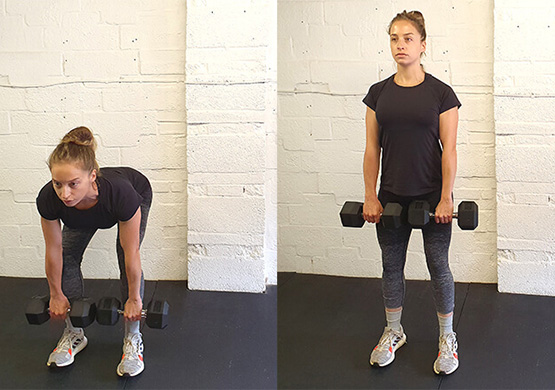
Recommended weight: Use a heavy dumbbell – 10kg.
This dumbbell workout move works: Hamstrings, glutes, core, lower back (posterior chain).
How to do a deadlift:
- Stand feet hip width apart, holding dumbbells in your hands, palms facing your knees.
- Throughout the movement, keep the shoulders squeezed back and down, the core engaged and the back straight.
- Hinge at the hips, gliding the hands down the face of the legs, until you need to bend the knees slightly.
- Finish at the ankles.
- Drive back up through the feet – back along the face of the legs.
- Squeeze the glutes at the top.
- If you feel your lower back rounding, start again with proper form or choose a lighter weight.
- Perform 10-12 reps.
2) Reverse Alternating Lunges
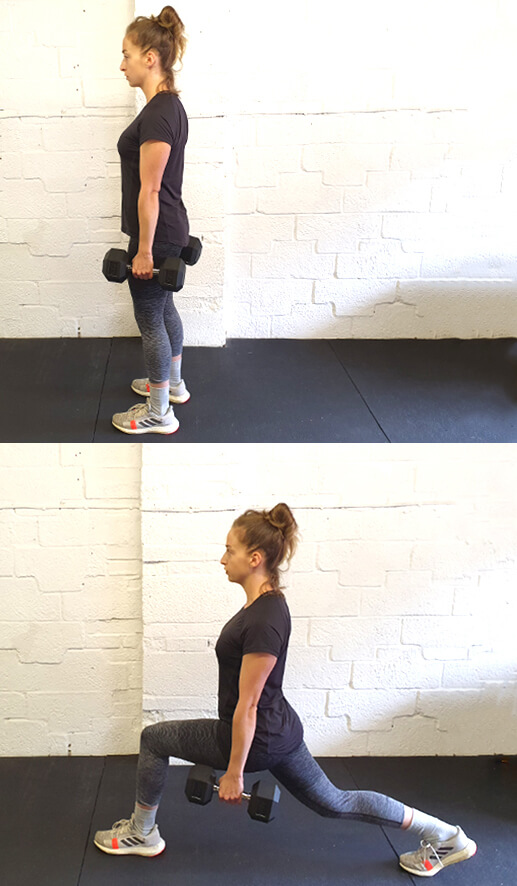
Recommended weight: Use a heavy dumbbell – 10kg.
This dumbbell workout move works: Glutes, quads and core.
How to do a reverse alternating lunge:
- Hold the dumbbells at your side, palms facing the side of your thighs, engage the core and keep the pelvis in neutral.
- Step backwards into a lunge position with the left foot – keep stable, the movement should be fluid and slow.
- Make sure the knee of the right leg does not pass over the toes of the right foot. The right leg should be bent into a perfect right angle.
- To return to centre by driving up through the right foot and squeezing the right glute.
- Alternate to the other side.
- Perform 10-12 reps on each side.
3) Squat into Push Press
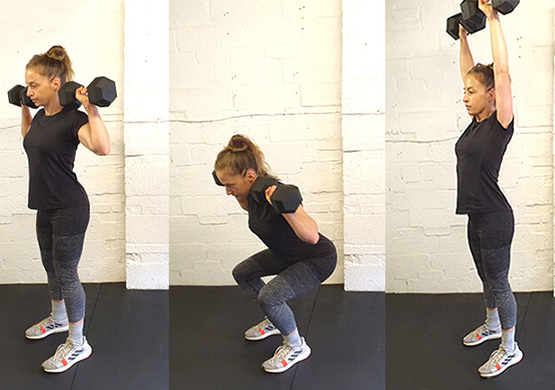
Recommended weight: Medium to heavy – 8-10kg.
This dumbbell workout move works: Quads, core, upper back and shoulders.
How to do a squat into push press:
- Start with the elbows raised above your shoulders, dumbbells either side of your ears, squeeze the shoulders back.
- Hinge at the hips, driving your buttocks backwards as though you were sitting on a chair behind you.
- Knees should be tracking over the ankle and not moving further forward than the toes, weight in the heels.
- Drive back up through the heels, squeezing the glutes, as you come towards standing start to squeeze the shoulders, driving the arms up into an overhead press.
- Bring the arms back down into the starting position.
- Ensure you keep a flat straight back throughout, with the core engaged and shoulders squeezed back and down.
- Perform 10-12 reps.
4) Russian Twists
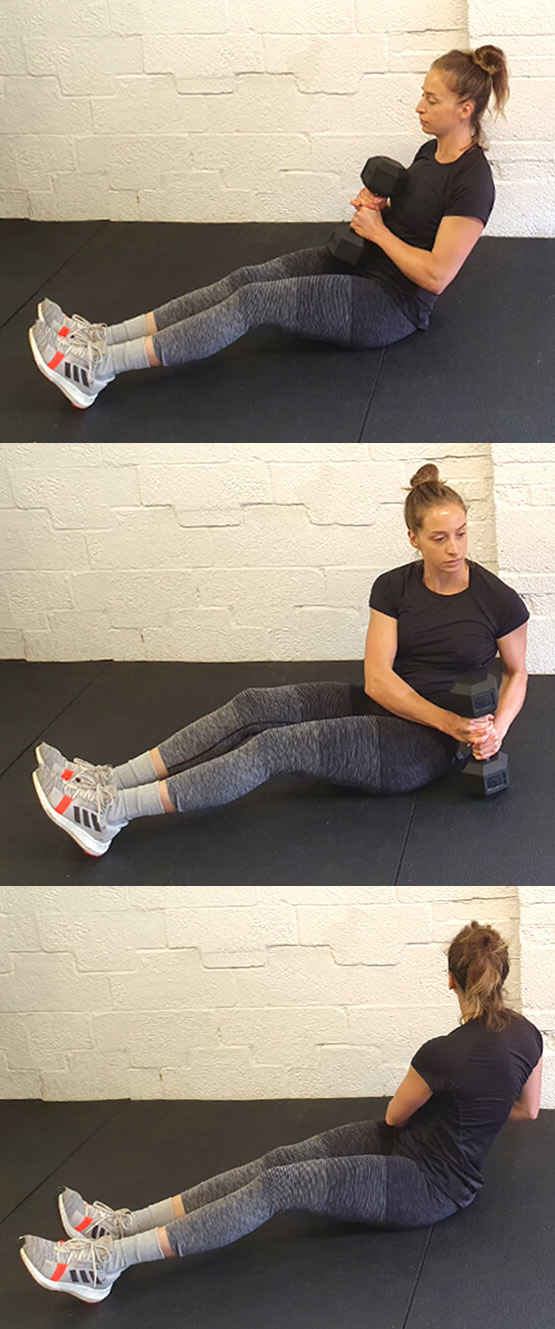
Recommended weight: Medium to heavy – 8-10kg.
This dumbbell workout move works: Core.
How to do a russian twist:
- Sit down with your legs out in front of you, your torso tilted back at a 45 degree angle.
- Knees should be slightly bent, with your heels resting on the floor.
- Hold one dumbbell with both hands, in front of you with your elbows bent.
- Twist your torso back and forth, so that you can tap the floor either side of your hips with the dumbbell.
- Tap 10 times each side.
5) Plank with Renegade Row

Recommended weight: Light – 2-4kg.
This dumbbell workout move works: Core.
How to do the plank with renegade row:
- Get into the plank position holding two light dumbbells, hands posted up on the dumbbells.
- Hold the plank, keeping the pelvis tucked in and glutes engaged, alternating a rowing action with each arm and the dumbbell.
- Keep the hips level.
- Keep going for 30 seconds.
6) Lateral Raises
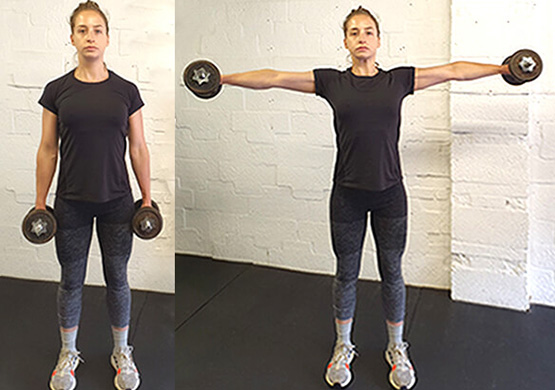
Recommended weight: Light to medium – 2-8kg.
This dumbbell workout move works: Shoulders (deltoids) front back and side.
How to do a lateral raise:
- Stand with feet hip width apart, holding a light weight.
- Arms down by your sides.
- Squeeze the shoulders back and down, and engage the core.
- Lift both arms up into a ‘T’ position.
- Control the movement.
- Lower them back down.
- Perform 8-10 reps.
7) Overhead Press

Recommended weight: Medium – 6-8kg.
This dumbbell workout move works: Chest, shoulders, triceps, upper back.
How to do an overhead press:
- Standing feet hip-width apart, core engaged and pelvis neutral.
- Bring the dumbbells up to shoulder height with your arms spread in a ‘W’ position.
- Push the weights up directly above, finish point is arms straightened above the head.
- Slowly bring them back down.
- Perform 8-10 reps.
8) Hammer Curl to Bicep Curl

Recommended weight: Light to medium – 2-6kg.
This dumbbell workout move works: Biceps
How to do a hammer curl to bicep curl:
Stand feet hip-width apart, core engaged and pelvis neutral.
Squeeze the shoulders back and down.
Arms straight down by your sides.
Palms facing inwards, hinge at the elbow and raise the hands to the shoulders, squeezing the biceps.
Twist the weights at the top so that they are now horizontal and lower back down, fully extending the arms.
Switch dumbbell position again to start the hammer curl portion of the next rep.
Perform 8-10 reps.
9) Overhead Tricep Extension

Recommended weight: Medium to heavy – 8-10kg.
This dumbbell workout move works: Triceps
How to do an overhead tricep extension:
- Standing feet hip width apart, core engaged and pelvis neutral.
- Hold one heavy dumbbell with both hands on the centre post.
- Raise the arms up, holding the weight above your head.
- Bend the elbows and lower the dumbbell as far as you can behind the head.
- Keep the elbows locked in position to isolate the movement in the tricep.
- Extend the arms to bring the weight directly above your head and repeat by lowering back down.
- Perform 8-10 reps.
Benefits of Using Dumbbells
If you are looking for equipment for weight training, dumbbells are a great place to start. I recommend that my clients use them because:
- You can work out the whole body.
- Dumbbells take up very little space compared to a barbell set.
- They help you to challenge any imbalances of strength between your two sides.
How to Choose the Best Dumbbells
There are two main types of dumbbell systems: adjustable weight systems and set weight systems.
Adjustable weight systems where you can adjust the weight of just one set. This can save on space, but there are drawbacks.
The traditional spin collar set (essentially nuts, bolts and weight plates) are incredibly fiddly to change the weight over mid workout. They are normal uncoated cast iron and would damage the floor if you drop them. Sometimes the spin collar comes loose and the plate clunks back and forth as you work out.
Within this category are more advanced weight systems. For example, dumbbells that you can adjust the weight off by simply turning a dial. These may be convenient but they are quite clunky and almost prohibitively expensive. These weights would also be damaged by being dropped.
Set weight dumbbells also come in a couple of different forms: hexagonal, round, and with different coatings. If you buy a dumbbell rack they are easily stored and endlessly convenient. You can quickly switch between weights mid workout. This allows you to complete ladder sets and circuits with speed.
Hexagonal topped dumbbells are a smart choice. Unlike round topped weights, hexagonal topped dumbbells won’t roll away when you put them down. You can also use them for any move where you post up on your hands, like the renegade row.
Rubber coated designs are less likely to damage surfaces and floors. They are generally quieter when you put them down.
What Weight Should I Start With?
To get started with dumbbell workouts, you’ll need a light, medium, and heavy weight. You could initially buy your estimated medium weight. After getting used to that, buy a lighter and heavier set.
Light will be around 2-4kg depending on your strength, gender and current routine. You want these for bicep curls, some ab exercises and shoulder exercises. Medium will be roughly 6-8kg.
Heavy will be 10kg and above. You don’t need to be able to lift this above your head. This will be used for lower body exercises.






